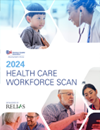

4 Ways Updating Workforce Models Can Deliver Big Results

Hospitals and health systems are reexamining and redesigning clinical care delivery and staffing strategies. This primarily is a response to the nation’s rapidly changing demographics and the large numbers of clinicians leaving the field due to retirement or other factors.
 And even though it’s still early in this transformation, many provider organizations are making impressive gains, notes the AHA’s recently released 2024 Health Care Workforce Scan. The report provides a wealth of examples of how provider organizations are piloting new care models and leveraging existing and emerging digital technologies to augment, support and streamline workforce roles.
And even though it’s still early in this transformation, many provider organizations are making impressive gains, notes the AHA’s recently released 2024 Health Care Workforce Scan. The report provides a wealth of examples of how provider organizations are piloting new care models and leveraging existing and emerging digital technologies to augment, support and streamline workforce roles.
As the report illustrates, health care leaders are reshaping their visions for workforce recruitment, training and sustainability while embracing new strategies and making important tweaks to programs that have served the field well for decades.
4 Ways Workforce Models Are Transforming
1 | Team-based care enters a new era.
The team-based care model has its roots in World War II when the military overcame nurse shortages by training ancillary health care staff and medics to work with nurses. The Veterans Administration health system later adopted the model, as did many other hospitals. The modern-day model takes a more interprofessional approach than the traditional model and is managed by an experienced team leader knowledgeable in critical or specialty care who oversees team members moved to the unit to assist with care.
Benefits of an interprofessional team-based approach vs. a primary nurse model include:
- Enables fewer specially trained physicians, advanced practice providers and RNs to manage a greater number of patients with the aid of support staff.
- Increases flexibility and agility to meet changing day-to-day needs and during crises.
- Provides added support for newly onboarded nurses.
- Improves quality, patient safety and staff satisfaction and can be more easily scaled to the acuity of the patient population.
Takeaway
Extensive formal and informal communication among the team leader and members, including frequent huddles and rounding, is essential to ensure safe, high-quality patient care. Training programs like TeamSTEPPS can help develop the necessary skill sets to work productively in a team-based environment.
2 | Flexible resource pools catch on.
Today’s flexible resource pools differ from yesterday’s float pools in three positive ways: (1) They use technology to forecast patient demand and combine precision scheduling and staffing, rather than relying on estimates and filling gaps at the last minute; (2) They are highly customized solutions designed to fit a health system’s specific needs, based on such factors as volume and census patterns; (3) They create a desirable choice for nurses seeking to build a variety of skills.
Jefferson Health’s Nursing SEAL (Service, Excellence, Advocacy, Leadership) Team improved nurse staffing, patient care and health system financing in less than a year. Like the Navy SEALS special operations forces, the agile Nursing SEAL Team is deployed wherever the need is greatest.
The team cares for patients across the health system’s 18 hospitals in southeastern Pennsylvania and southern New Jersey, meeting 12%-16% of identified staffing needs on a weekly basis — needs that previously went unfilled or were filled with core staff overtime, agency nurses or premium-paid shifts.
Takeaway
Using a flexible resource pool instead of external agency nurses supports more consistent patient care while also enabling significant savings.
3 | Gig work gains a foothold.
Embracing the gig economy has helped health systems like Chesterfield, Missouri-based Mercy fill staffing gaps, reduce costs and boost nurse satisfaction. Using apps like ride-sharing tools connects hospitals to a broader and more fluid labor pool and gives nurses more control than they have with agency contracts.
Mercy rolled out an app and online platform in the spring that enables its part-time nurses, as well as other local nurses, to pick up gig shifts across its 45 hospitals in Missouri, Oklahoma, Arkansas and Kansas. The initiative proved popular with nurses, bringing back joy in practice through improved work-life balance.
Takeaway
Mercy achieved a 50% decrease in agency spend, saving more than $5 million. Meanwhile, its fill rate improved by 2%, achieving a target fill rate of 86%, and the program improved retention and recruitment by creating a gig workforce of 1,100 nurses.
4 | Virtual nursing gets a makeover.
Many health systems are piloting and scaling up their virtual nursing programs to supplement staffing. Virtual nursing through partnerships with telehealth providers or development of homegrown solutions allows nurses to work remotely and frees up bedside nurses to provide more physical and emotional care.
When Renton, Washington-based Providence introduced an innovative Co-Caring virtual nursing model, it did more than add a virtual nurse to the care team; it adjusted all provider roles. Home-based virtual nurses support bedside caregivers by helping with discharge, medication reconciliation and other administrative tasks, allowing nurses to practice at the top of their licenses and boosting satisfaction. First-year turnover rates at Covenant Medical Center, which piloted the program, dropped by 73% for RNs and 55% overall.
Takeaway
Deploying technology to facilitate gig shift selection can reduce spending, increase staff flexibility and offer the potential for increased job satisfaction.



